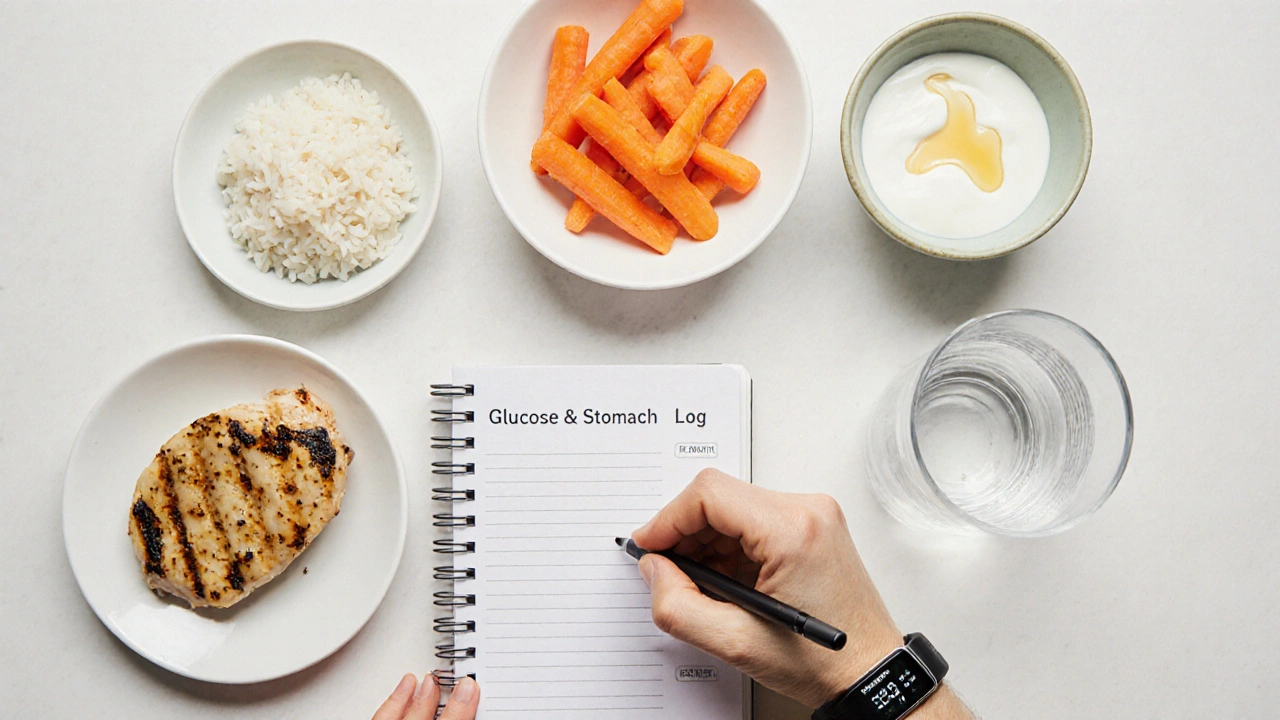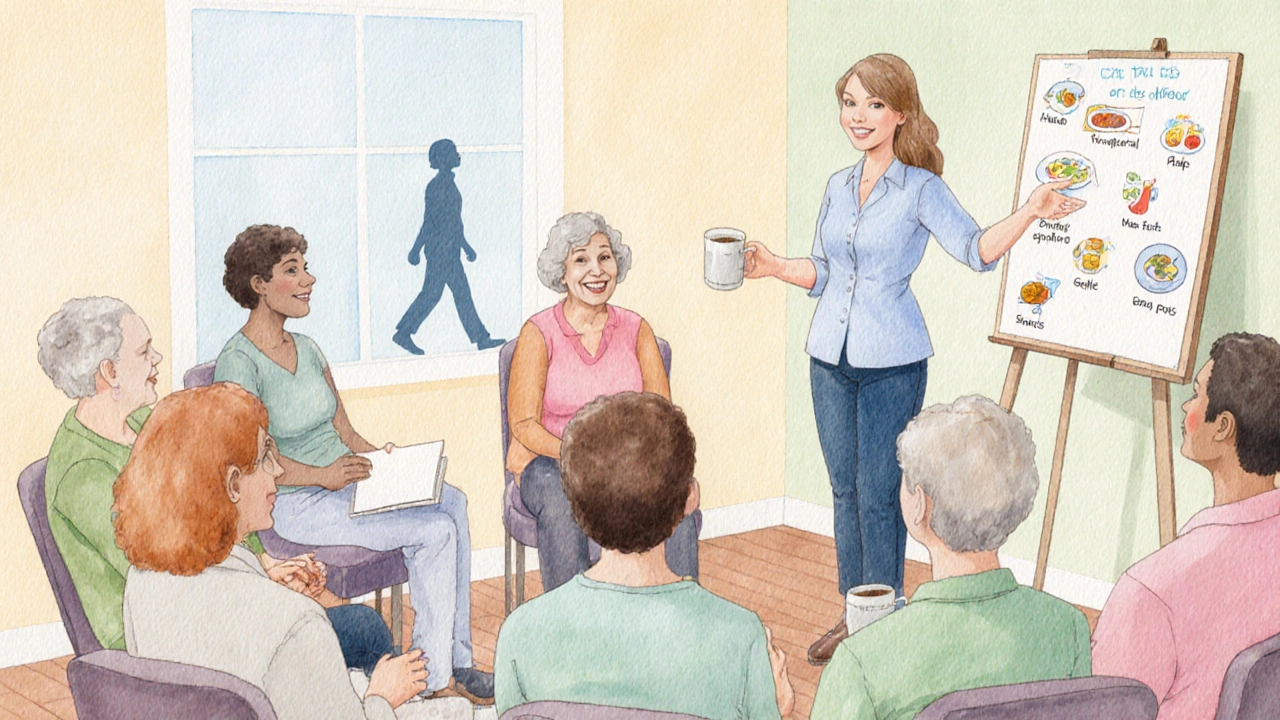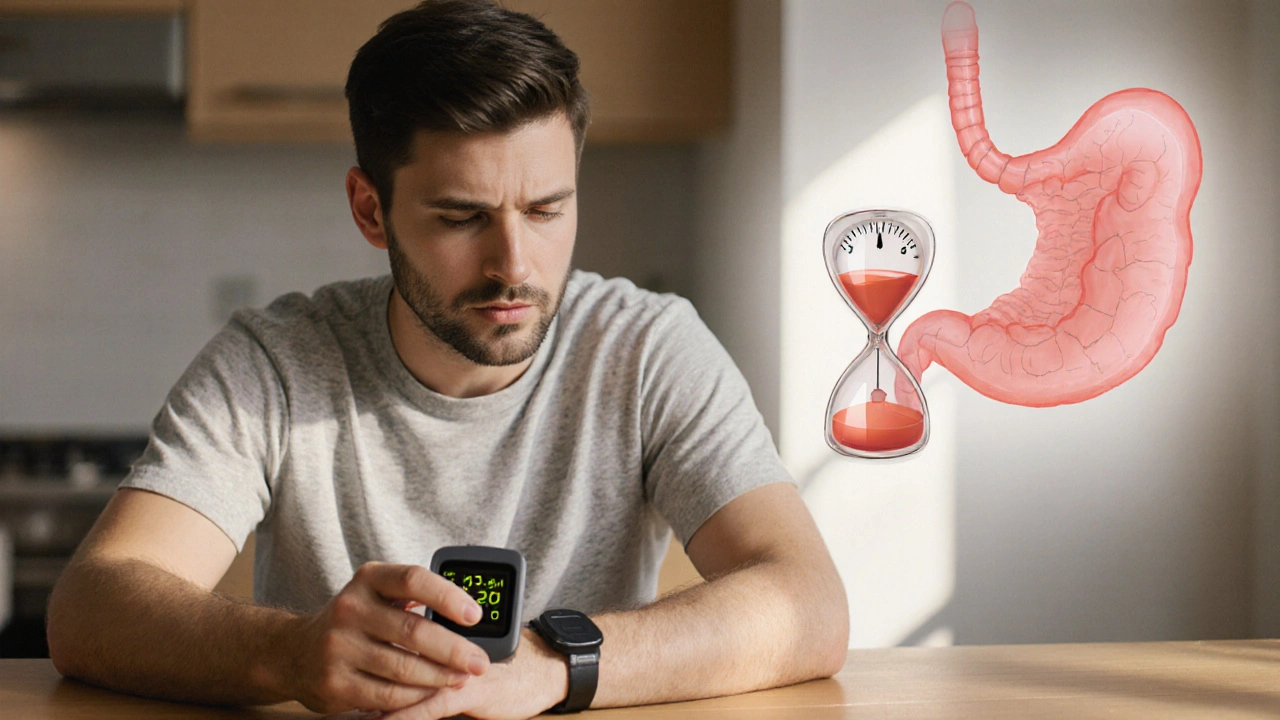Gastroparesis Meal Planning Helper
Plan Your Day
Select meal types to generate a sample menu tailored for managing diabetic gastroparesis.
Your Personalized Meal Plan
Diabetic Gastroparesis is a condition where long‑term diabetes slows the stomach’s ability to empty food, leading to nausea, bloating, and erratic blood‑sugar spikes. When the stomach lags, the usual rhythm between meals and insulin gets thrown off, making glucose control feel like a roller‑coaster.
Key Takeaways
- Track bloodglucose closely and pair readings with symptom notes.
- Choose low‑fiber, low‑fat meals in small, frequent portions.
- Medications such as metoclopramide or domperidone can boost gastric motility, but watch for side effects.
- Stay upright after eating and consider gentle movement to aid digestion.
- Lean on diabetes educators, dietitians, and support groups for ongoing encouragement.
Understanding the Condition
The stomach normally empties about 2-4hours after a meal. In gastroparesis, that timeline stretches to 6hours or more. The delay messes with the timing of insulin, so even a perfectly balanced plate can send glucose soaring.
Two main factors drive this slowdown. First, high blood‑sugar levels over years damage the vagus nerve, the main highway that tells the stomach to contract. Second, certain diabetes medications (especially some GLP‑1 agonists) can further slow gastric motility. Knowing the why helps you target the right fixes.
Monitor Blood Sugar and Gastric Emptying
Traditional glucose logs still matter, but add a column for "stomach feeling" - e.g., bloated, early satiety, nausea. Over a week you’ll spot patterns: a spike after a high‑fat dinner? A dip when you skip breakfast?
Consider a simple home test for gastric emptying: eat a standard toast with a known amount of butter, then record when you feel hungry again. Repeating this every few weeks gives you a personal baseline, helping you judge whether a new medication is actually moving things along.
When using continuous glucose monitors (CGMs), set alerts for rapid rises that often correlate with delayed emptying. This real‑time feedback lets you intervene - perhaps with a short walk or a tiny snack of easily digestible carbs.

Smart Food Choices
Food is both the problem and the solution. The goal is to give the stomach manageable work while keeping blood sugar steady.
Low‑fat, low‑fiber meals empty faster. Think skin‑less poultry, lean fish, and white rice rather than whole grain or beans. Fat slows gastric emptying by 30% on average, so keep added oils to a teaspoon or less per meal.
Split your daily calories into 5-6 mini‑meals, each about 200-300kcal. Smaller volumes reduce the pressure on the stomach wall, cutting back on nausea and fullness.
Here’s a sample day:
- Breakfast: Greek yogurt (plain) + a drizzle of honey + a few berries.
- Mid‑morning snack: A small banana.
- Lunch: Grilled chicken breast, white quinoa, steamed carrots, and a splash of low‑sodium broth.
- Afternoon snack: Rice crackers with a thin layer of low‑fat cheese.
- Dinner: Baked cod, mashed potatoes (no butter), and peeled zucchini strips.
- Evening snack (if needed): A half‑cup of applesauce.
Hydration matters, too. Sip water throughout the day, but avoid large gulps with meals - they can over‑fill the stomach and worsen delayed emptying.
Medication and Prokinetic Options
When diet tweaks aren’t enough, doctors can prescribe medicines that stimulate stomach contractions.
Common choices include:
- Metoclopramide - boosts motility and can improve nausea, but watch for tremor or fatigue after weeks of use.
- Domperidone - similar effect with fewer central nervous‑system side effects, though it’s not FDA‑approved in the U.S. and may require a special pharmacy.
- Erythromycin (low‑dose) - an antibiotic that also acts as a motilin agonist, helping the stomach contract. Use short courses to avoid resistance.
Below is a quick side‑by‑side view of these options:
| Medication | Primary Action | Typical Dose | Key Side Effects | Availability (U.S.) |
|---|---|---|---|---|
| Metoclopramide | Dopamine antagonist - speeds gastric emptying | 10mg before meals, up to 4×/day | Tremor, fatigue, rare tardive dyskinesia | Prescription |
| Domperidone | Peripheral dopamine blocker - improves motility | 10mg 30min before meals, 3×/day | QT prolongation (monitor ECG) | Specialty pharmacy import |
| Erythromycin (low‑dose) | Motilin receptor agonist - triggers contractions | 250mg once daily | GI upset, possible antibiotic resistance | Prescription |
Always discuss risks with your endocrinologist or gastroenterologist. Some patients combine a low‑dose prokinetic with a short‑acting insulin analog to better sync insulin peaks with delayed meals.
Lifestyle Tweaks to Reduce Discomfort
Beyond food and pills, everyday habits can make a world of difference.
- Stay upright for at least 30minutes after eating. A gentle walk, light house chores, or even a standing desk session helps gravity do its part.
- Gentle abdominal massage in a clockwise direction for 2-3 minutes can stimulate peristalsis. Do it right after a meal, not during.
- Mindful breathing - slow diaphragmatic breaths reduce nausea and improve vagal tone. Try four‑second inhales, hold for two, exhale for six.
- Avoid smoking and alcohol. Both irritate the stomach lining and can worsen motility.
- Stress management - chronic stress spikes cortisol, which can impair gastric emptying. Mini‑meditations, yoga, or a short hobby break are worth the time.

Emotional Support and Resources
Living with diabetic gastroparesis can feel isolating. Connecting with others who "get it" eases the mental load.
Consider these options:
- Diabetes education centers - many offer group classes on nutrition and medication timing.
- Online forums - sites like DiabetesMine and the Gastroparesis Patient Alliance host real‑life tips.
- Registered dietitians specializing in gastroparesis - a 30‑minute session can fine‑tune your meal plan.
- Psychologists or counselors - cognitive‑behavioral therapy helps manage anxiety around eating.
Keep a simple log of what works and what doesn’t. Over time you’ll build a personalized toolkit that you can share with new providers, saving everyone time.
Quick Checklist for Daily Management
- Log blood‑glucose and stomach symptoms together.
- Eat 5-6 small meals, low‑fat, low‑fiber.
- Stay upright 30min post‑meal; walk gently.
- Take prescribed prokinetic medication as directed.
- Hydrate slowly throughout the day.
- Review your log weekly; adjust meds with doctor.
- Reach out to a support group or dietitian monthly.
Frequently Asked Questions
Can I still eat fiber if I have diabetic gastroparesis?
Fiber slows stomach emptying, so high‑fiber foods like beans, whole grains, and raw vegetables often worsen symptoms. Small amounts of soluble fiber (e.g., oatmeal) can be tolerated if spread across meals, but it’s best to keep total fiber under 15g per day and watch your symptom log.
Is it safe to use over‑the‑counter antacids?
Most antacids are fine, but those containing aluminum or magnesium can further slow gastric emptying. If you need heartburn relief, opt for a short‑acting H2 blocker like famotidine after consulting your doctor.
How often should I see my gastroenterologist?
If symptoms are stable, a 6‑month check‑in is typical. However, if you notice new vomiting episodes, sudden weight loss, or erratic glucose spikes, schedule an appointment sooner.
Can exercise improve gastric emptying?
Light to moderate activity, such as walking or gentle cycling, performed 30minutes after meals, can aid motility. High‑intensity workouts right after eating may worsen nausea, so keep intensity low for the first two hours.
What should I do if I vomit after a meal?
Pause solid food for at least 2hours. Sip clear liquids (water, electrolyte solution) in small sips. When you feel ready, restart with a bland, low‑fat item like plain toast. Record the incident to discuss with your healthcare team.

BLAKE LUND
October 9, 2025 AT 14:48Wow, navigating diabetic gastroparesis can feel like sailing through a foggy sea, but with the right meal‑plan tweaks you can steer clear of the stormy spikes. Cutting back on heavy fats and hugging those bite‑size meals is the secret sauce for smoother glucose waves.
Veronica Rodriguez
October 9, 2025 AT 15:21Great tip-staying upright after meals really does the trick 😊
Holly Hayes
October 9, 2025 AT 15:55Honestly, if you're still chugging whole‑grain loaves, you're basically sabotaging your own digestion-low‑fiber, low‑fat is the only haute‑cuisine for gastroparesis, duh.
Matthew Shapiro
October 9, 2025 AT 16:28I’ve found that logging both blood sugar and a quick “stomach feels” note after each bite helps spot patterns fast. For example, a buttery sauce usually flags a delayed spike, so swapping it for a splash of lemon can keep things steady.
Julia Phillips
October 9, 2025 AT 17:01The gut feels like a reluctant performer on opening night, trembling under the weight of every bite, but a gentle walk and a whisper of low‑fat protein can coax it back into the spotlight.
Richa Punyani
October 9, 2025 AT 17:35It is imperative to approach each day with structured optimism; begin by dividing your caloric intake into five modest meals, each carefully balanced for low fat and low fiber. Consistently sipping water in measured sips rather than gulping will further aid gastric motility. Moreover, engaging in a brief, calming breathing exercise post‑prandially can enhance vagal tone, thereby supporting smoother digestion. Such disciplined practices, when adhered to diligently, have been shown to markedly improve glycemic stability.
Bhupendra Darji
October 9, 2025 AT 18:08Absolutely, I’ll add a short breathing routine right after lunch; thanks for the suggestion.
Robert Keter
October 9, 2025 AT 18:41Managing diabetic gastroparesis is undeniably a multifaceted challenge that obliges us to rethink conventional dietary wisdom in a systematic way. First and foremost, the principle of volume control cannot be overstated; by limiting each eating episode to roughly 200 to 300 calories, we grant the stomach a manageable workload. Second, the macronutrient composition of those meals demands careful scrutiny, favoring lean proteins such as skinless poultry or white‑fish while eschewing high‑fat accompaniments that act as brakes on gastric emptying. Third, the timing of insulin administration must be synchronized with the delayed gastric transit, often necessitating a shift to rapid‑acting analogs taken shortly before or even after the meal, depending on individual response. Fourth, the strategic inclusion of low‑glycemic, low‑fiber carbohydrates-think white rice or refined pasta-helps moderate postprandial glucose excursions while not overwhelming the gastrointestinal tract. Fifth, adopting an upright posture for a full thirty minutes after consumption facilitates gravity‑assisted gastric emptying and can be complemented by a gentle stroll or light housework to further stimulate peristalsis. Sixth, regular, low‑dose prokinetic therapy, under vigilant medical supervision, can restore motility without imposing the neuropsychiatric side effects associated with higher dosages. Seventh, meticulous hydration-sipping water intermittently throughout the day rather than during meals-prevents overdistension of the stomach and supports overall metabolic function. Eighth, a disciplined symptom‑log that records not only glucose values but also subjective sensations such as nausea, fullness, or early satiety, provides a data‑driven foundation for iterative adjustments. Ninth, seeking multidisciplinary support-from endocrinologists to dietitians specialized in gastroparesis-ensures that therapeutic decisions are both evidence‑based and personally tailored. Finally, cultivating a resilient mindset, perhaps through mindfulness practices or support groups, helps mitigate the psychological toll that chronic dysregulation can exact. By integrating these tenets into a cohesive daily routine, patients can transform a seemingly insurmountable condition into a manageable component of their broader diabetes care plan.
Rory Martin
October 9, 2025 AT 19:15One must consider that excessive reliance on over‑the‑counter antacids may inadvertently prolong gastric emptying; thus, consulting a physician before routine use is advisable.
Maddie Wagner
October 9, 2025 AT 19:48Remember, you are not alone in this battle; the community stands ready to share recipes, coping hacks, and a listening ear, turning each daunting meal into a shared triumph.